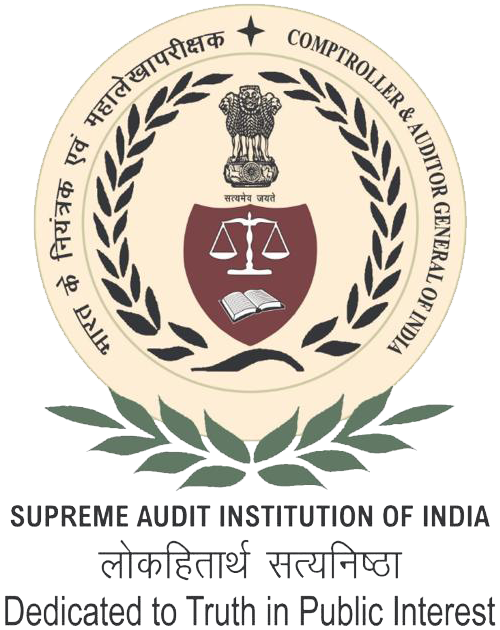Audit Reports

Karnataka
Compliance Audit on Departments and Public Sector Undertakings for the year ended March 2022
Overview
This Report contains three Chapters. Chapter-I on Introduction to Government Departments audited by the Office of the Principal Accountant General (Audit-II), Karnataka, Chapter-II (Compliance Audit Observations on Departments) and Chapter-III (Compliance Audit Observations on Public Sector Undertakings). Chapter-II contains sixteen compliance audit paragraphs pertaining to Hindu Religious Institutions and Charitable Endowments Department, Forest, Ecology and Environment Department, Mines and Geology Department, Home Department, Department of Administration of Justice, Urban Development Department, Public Works Department, Department of Kannada and Culture and Department of Tourism. Chapter-III of the Report contains three compliance audit paragraphs pertaining to three public sector undertakings coming under the administrative control of Energy Department and Commerce and Industries Department. The overview of the Report is given below.
1. Introduction
This Report relates to matters arising from the Compliance Audit of Government Departments and Autonomous Bodies. Compliance Audit refers to examination of the transactions of the audited entities to ascertain whether the provisions of the Constitution of India, applicable laws, rules, regulations and various orders and instructions issued by competent authorities are being complied with.The primary purpose of the Report is to bring important results of audit to the notice of the State Legislature. The audit findings are expected to enable the Executive to take corrective actions, to frame policies and issue directives that will lead to better governance.
Expenditure Profile
There are 21 departments falling under the jurisdiction of under the jurisdiction of Office of the Principal Accountant General (Audit-II). The total expenditure outlay of these departments for the year 2021-22 was ₹57,914.62 crores.
2. Coverage of Report related to Departments
The Compliance Audit Observations related to departments are included in Chapter II of Part I and the gist of the observations are given below.
Management of Hindu Religious Institutions by the State Government
The Hindu Religious Institutions and Charitable Endowments Department of Government of Karnataka is responsible for distribution of grants for temple development, exercising supervisory control over temple administration, protecting temple land, etc. During joint inspection and through verification of records, Audit noticed that there were disparities between estimates and actual work executed. The monitoring of schemes and work execution was not satisfactory.The Tasdik and Varshasana grants, which are statutory in nature, also lay undisbursed with the Tahsildars. Large sums of grants released were kept in bank accounts at the District and Taluk offices without being spent for the purpose for which it was granted.
Further, Audit observed that there was inadequate monitoring of notified institutions. The Department did not make any concerted effort to conduct surveys and ensure eviction of encroachments in properties. The annual budget proposals of the notified A and B category institutions were not received regularly. None of the notified C category institutions in test-checked Districts submitted their annual budget proposals for the last five years. In addition, there was a shortfall in receipt of Common Pool Fund to the extent of ₹ 15.23 crore from notified institutions.
The Department did not ensure the registration of all private institutions as mandated, and this skewed the distribution of benefits. Manpower deficit in the Department hugely affected the capacity to supervise and ensure proper implementation of schemes.
(Paragraph 2.1)
Management of Forest Offense Cases in Karnataka Forest Department The Compliance Audit was to assess whether prescribed system and procedures are being followed for Detection and Disposal of FOCs. The important findings of the audit are given below:
➢ Disposal of Forest Offense Cases (FOC) was very low and there were arithmetical errors in MIS reports on FOCs.
➢ No action was taken to evict encroachers in 1,322 cases involving 1,188.11 Ha of land where competent authorities rejected the applications by encroachers to regularise the un-authorised occupation of forest lands. Similarly, 3,382 cases (out of 4,026 cases) involving Audit analysis revealed that a large number of grants were released without receipt of proposals through laid down channels. There was no uniformity in procedure for disbursal of Government grants to institutions. Further, Audit observed that there was disparity in release of grants between notified institutions and private institutions. There were instances of the Department’s use of grants in violations of Department’s own circular instructions. There was a rush of expenditure during the month of March resulting in unauthorised parking of funds outside the treasury and nonutilisation funds thereof. Audit also observed huge pendency in submission of Utilisation Certificates by the institutions. These issues indicated improper financial management.
22,173.15 acres (out of 29,688.68 acres) of forest lands that were to be evicted by June 2016 (as per the Action Plan filed by the Government of Karnataka before Hon’ble High Court of Karnataka) continued to be under encroachment.
➢ Omission to mutate lands notified as forest lands in favour of Forest Department was leading to unauthorised grant of forest land by Revenue Authorities. 1.98 lakh Ha of forest land in the selected 11 divisions are yet to be mutated in favour of the Forest Department. Audit noticed that 182.50 Ha of notified forest lands were granted by Revenue Authorities during the years 2016-17 to 2021-22.
➢ Quantum of punishments on compounding was found to be very less and disproportionate to the offense. In five cases of attempt to encroach forest land for cultivation by felling trees and levelling land using JCBs or Tractors, compounding fine ranging from ₹2000 to ₹26,000 only was levied without confiscating the vehicles, machineries and equipment used in the offense. Similarly, in one case of illegal felling of 873 trees by a contractor the case was closed by levying compounding fine of ₹50,000 only.
➢ An analysis of status of FOCs in a sample of 2,541 cases registered between 2017-18 and 2021-22 in the 22 RFOs under 11 selected Divisions revealed that about 57 per cent of the cases were pending for prompt first level follow-up action such as filing of Enquiry Reports and Charge Sheets by the Departmental Officers.
➢ The seized material valuing ₹34.07 crore was pending for disposal were kept at Divisions without taking steps for safe custody and timely disposal of the same to realise revenue to Government.
(Paragraph 2.2)
Omission to ascertain the price of used rails from Railway Department and erroneous inclusion of GST in the cost of used rails in construction of elephant barricades in three Forest Divisions resulted in avoidable excess expenditure and double payment of GST to contractors aggregating to ₹ 2.41 crore.
(Paragraph 2.3)
The Mines and Geology Department did not levy/collect the Royalty and Additional Periodic Payment on minimum production quantity of ordinary sand during 2017-18 to 2021-22 in eight test checked Districts aggregating to ₹ 493.90 crore.
(Paragraph 2.4)
Non-compliance by Fire and Emergency Services Department to the Government directives regarding fire safety provisions in high-rise buildings led to the risk of adversely impacting fire protection preparedness endangering Compliance Audit Paragraphs public life and property besides non-collection of prescribed revenue amounting to ₹ 165.24 crore.
(Paragraph 2.5)
The office of the Superintendent of Police, Ballari did not follow the legalities for transfer of Government land to a private association, resulting in un-authorised utilisation of Government property worth ₹ 9.94 crore and loss of Government revenue to the tune of ₹ 2.73 crore.
(Paragraph 2.6)
Embezzlement of Government receipts of ₹ 2.27 crore through fraudulent practices and manipulation of records was observed in the office of Honourable Chief Judicial Magistrate, Bengaluru Rural. The embezzlement remained undetected for more than four years due to failure in following the prescribed
internal control procedures.
(Paragraph 2.7)
The decision of Bengaluru Development Authority to prepone the effective date of implementation of the amended incentive scheme rules without authority of law along with allocation of sites (in the previously formed layouts in violation of the rules) resulted in excess allocation of 12,000 sq. of developed land and undue benefits to landowners to the tune of ₹ 10.54 crore.
(Paragraph 2.8)
Failure of Bangalore Development Authority to follow the due procedure prescribed for collection of betterment tax (even after three years since Government approval authorising its collection), resulted in realisation of only ₹ 3.22 crore out of ₹ 3,503.63 crore projected to be collected from Arkavathy and Nada Prabhu Kempe Gowda layouts.
(Paragraph 2.9)
Adoption of inappropriate price index to regulate price adjustment for steel pipes in water supply works by Bengaluru Water Supply and Sewerage Board resulted in avoidable extra expenditure of ₹ 2.63 crore.
(Paragraph 2.10)
Non-settlement of land compensation dues in full by Executive Engineer, PWD Division, Dharwad resulted in extra interest of ₹ 7.47 crore to be borne by the Government which was avoidable.
(Paragraph 2.11)
Chief Engineer, National Highways, Bengaluru and Executive Engineer, Public Works Department, Bengaluru failed to include the cost of acquisition of land in the estimates and acquire the land before entrustment of the works.The omissions led to abandonment of work in one case and in the other case, a bridge constructed remained without approach roads.
(Paragraph 2.12)
Government money to the extent of ₹1.78 crore was misappropriated by preparing fake work bills relating to annual road maintenance works in PWD Division, Koppal.
(Paragraph 2.13)
Cancellation of tender process and initiating fresh tender process for the work
due to defective tender document by EE, NH Division, Hassan resulted in additional financial burden of ₹ 3.73 crore to the public exchequer. Further, the completion of the work was also delayed, causing inconvenience to the public.
(Paragraph 2.14)
Delay in construction of Rangamandira at Davanagere for over a period of 10 years, splitting of works, non-adherence to KTPP rules led to unfruitful expenditure of ₹ 4.19 crore.
(Paragraph 2.15)
Inordinate delay in construction of Yatri Nivas at Gubbi led to unfruitful expenditure of ₹ 44.46 lakh and further cost escalation of ₹ 37.69 lakh.
(Paragraph 2.16)
3. Coverage of Report related to PSUs
The observations included in this Chapter highlight deficiencies in planning and contract management in the management of PSUs, which resulted in financial irregularities. Gist of the important audit observations is given below:
➢ Karnataka Renewable Energy Development Limited suffered a loss of ₹2.64 crore in the project due to short claim/receipt of Service charges, penalty charged by MNRE for delay and non-receipt of contribution due from the State Government. The State could commission only 43 per cent of Solar Water Pumps (SWP) envisaged.
(Paragraph 3.1)
➢ Abnormal delay in construction of building by Karnataka State Handicrafts Development Corporation Limited resulted in avoidable payment of rent of ₹ 12.78 crore.
(Paragraph 3.2)
➢ The Board of Karnataka Soaps and Detergents Limited decided (December 2020) to discontinue the use of Vetivert oil in production of MSS perfume. However, 1,893 kgs of Vetivert oil was procured in February 2021 resulting in avoidable expenditure of ₹ 4.87 crore. )
(Paragraph 3.3)
Submission of accounts by PSUs
As on 31 March 2022, there were 125 PSUs in Karnataka of which 79 PSUs are falling under the jurisdiction of Office of the Principal Accountant General (Audit-II). Of these, 68 PSUs including four Statutory Corporations were working and 11 Companies were non-working as on 31st March 2022. During the year, 56 accounts pertaining to 51 PSUs were finalised, which included two accounts of four Statutory Corporations. The number of accounts in arrears increased from 31 (2019-20) to 68 (2021-2022). Of the 68 arrears of accounts, 62 accounts pertained to the working Government Companies, which were in arrears ranging between one and seven years and six accounts pertaining to four Statutory Corporations, which were in arrears ranging between one and two years.
(Paragraph 3.4)
Download Audit Report
- Introduction
- Observations on Departments
- Observations on Public Sector Undertakings
- ಪೂರ್ಣ ಕನ್ನಡ ವರದಿ
- ಪರಿಚಯ
- ಇಲಾಖೆಗಳ ಮೇಲಿನ ಅನುಸರಣಾ ಲೆಕ್ಕಪರಿಶೊಧನೆಯ ಕ೦ಡಿಕೆಗಳು
- ಸಾರ್ವಜನಿಕ ವಲಯ ಉದ್ದಮೆಗಳ ಅನುಪಾಲನಾ ಲೆಕ್ಕಪರಿಶೊಧನೆಯ ಕ೦ಡಿಕೆಗಳು

